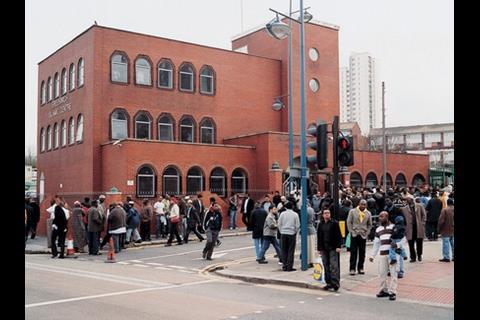BritainŌĆÖs mosques are so full that worshippers at this one in Greenwich are spilling onto pavements and car parks. But although the pressure for more of them is growing, work is being held back by planning problems, lack of cash and dismal designs.
The nationŌĆÖs mosques are ŌĆ£full to burstingŌĆØ, according to a spokesperson for the Muslim Council of Britain. ŌĆ£There are mosques where people are praying outside, putting their carpets down in the street.ŌĆØ
It seems that the UK needs more mosques and those is already has need expanding. ║├╔½Ž╚╔·TV them should, in theory, be a pretty attractive proposition for the construction industry. For one thing, they can be large projects: the proposed Markaz Mosque in the Newham, east London, could cost up to ┬Ż300m. And mosques are among the most beautiful buildings anywhere. Witness IstanbulŌĆÖs Blue Mosque, with its cascade of magnificent domes surrounded by six slender minarets.
The truth is though that despite the demand, mosque building in the UK is plagued by planning struggles, lack of money and uninspiring designs.
The MCB spokesperson says: ŌĆ£Not only is the Muslim population growing in Britain but so is the converted population. As a result, mosques are absolutely chock-a-block. Often the whole family canŌĆÖt go to mosque; they are forced to stay at home because there isnŌĆÖt enough space.ŌĆØ
The Greenwich Islamic Centre in Plumstead is a prime example. Every Friday lunchtime, when the most important prayer of the week takes place, some 2,000 worshippers descend on the small building. This is around 75% more than the building can cope with, say the trustees of the building. The devout are forced to put their mats down and pray in the car park and even on the grotty pavement outside.
The Greenwich Islamic CentreŌĆÖs trustees managed to scrape plans for a centre through the planning system last month. But it has been a struggle and even now the project is far from straightforward. Planning permission is the first, and perhaps the biggest, hurdle facing mosque schemes. ŌĆ£People oppose mosques for all sorts of reasons,ŌĆØ says the MCB spokesperson.
In Newham, the Markaz Mosque, also known as the Abbey Mills Mosque, faces fierce opposition. It has been dubbed the mega-mosque in the local press because it will have capacity for 12,000 worshippers, which would make it BritainŌĆÖs largest mosque. ItŌĆÖs also on the doorstep of the Olympic site, next to West Ham tube station.
Alan Craig, a local councillor and leader of the Newham branch of the Christian Peoples Alliance, is openly against the mosque. He says: ŌĆ£This is a security issue. We donŌĆÖt need a socking great monstrous mosque coming here and preaching separatism. I am aghast that Newham council is even considering granting planning permission.ŌĆØ
His beef is with the people who are proposing to build the Marzak: Tablighi Jamaat, an international missionary group founded in India in the twenties. Craig claims the mosque would pose a security risk because of Tablighi JamaatŌĆÖs alleged links to terrorism. He also says the group advises its members not to mix with the rest of society, which is ŌĆ£something we donŌĆÖt want down here in east London where people of different religions get on wellŌĆØ. He says he would not oppose the mosque if the client were ŌĆ£a sensible, moderate groupŌĆØ.
Faisal Iqbal of Tablighi Jamaat is a member of the Abbey Mills Mosque. He insists that the group supports neither terrorism nor separatism. ŌĆ£Our organisation is not under cover. We are slap bang in the middle of London. As for terrorism, we are moving people away from extremist views. We work with Special Branch and the Metropolitan Police. If we were preaching something extremist, theyŌĆÖd be all over us.ŌĆØ
He says that being accused of supporting terrorism has become ŌĆ£the norm for MuslimsŌĆØ. In the seventies, it was the same for Irish people: everyone thought they supported the IRA.
They want to build the mosque, he says, because the existing building at the site is struggling to cope with visitor levels. Up to 4,000 people visit at a time and the mosque is asking people to stay away.
John Rees, national secretary of the Respect party, says the building of mosques has become highly political because of the environment created by the invasions of Afghanistan and Iraq. ŌĆ£People think that Muslims all hold one particular view. But thatŌĆÖs like saying all Christians support George Bush. Muslims hold a variety of views, just like any other group of people.ŌĆØ
Even the relatively small ┬Ż8.7m rebuild of the Greenwich centre had to fight for planning permission. The centreŌĆÖs trustees dropped their original project manager because pre-application advice from the council suggested that the scheme would not win planning permission.
It then appointed an expert in mosque projects, Catalyst Regeneration. Catalyst has about ┬Ż70m of construction projects on its books, of which ┬Ż20m are mosques. The Birmingham-based firm is handling project management, design and cost control for Greenwich, which was eventually given planning consent on its first attempt.
Billal Raza, development project manager at Catalyst, says: ŌĆ£The client brought us in because it needed someone with experience of getting planning approval for Islamic centres in London. We have 20 yearsŌĆÖ experience of designing mosques.ŌĆØ
He says Catalyst has had to develop a meticulous approach to applications: ŌĆ£ItŌĆÖs difficult negotiating these types of projects. So many battles are fought to build them because communities misunderstand what is being proposed.ŌĆØ To address this, Raza says he goes into plenty of detail. ŌĆ£We always explain the purpose of the building, what we are proposing and why. On another scheme, the local authorityŌĆÖs urban planner couldnŌĆÖt understand our design. We had to explain that men and women must be segregated in the mosque, so they have separate entrances. We also had to explain that a mosque must be orientated towards the big cube in Mecca, the Kaaba, because all Muslims pray towards it.ŌĆØ
Planning authorities may also be confused about when the building will be used. ŌĆ£In the height of summer the first prayer will be at 5am but this moves towards seven in the morning in winter,ŌĆØ says Raza.
Unlike its current incarnation, the new Islamic centre at Greenwich will look like a mosque, complete with dome and a large minaret. This has brought further problems, says Raza. ŌĆ£Planning authorities worry that the call to prayer will be broadcast over the neighbourhood through the minaret.ŌĆØ But he says Greenwich will avoid the row that has erupted in Oxford over the proposal to broadcast the call: it will only be audible within the walls of the mosque.
Fears that a mosque will cause separatism had also to be addressed. In the case of Greenwich, Raza believes the planning application was strengthened by the inclusion of sports facilities that will be open to non-Muslims. It was also made clear that the building would have an ŌĆ£open and friendly designŌĆØ. This is being achieved by lots of windows and making sure security features such as CCTV have a low profile.
Security is a big issue. At Greenwich, the client has had to meet extra requirements from the police. Raza says that initially Greenwich police wanted ŌĆ£a big steel fence around the centre and for anyone visiting the mosque to have an electronic passŌĆØ.
But security measures had to be balanced against the need for a ŌĆ£friendly designŌĆØ.
So, a compromise was reached: there will be no fence or entry passes, but there will be security officers at the buildingŌĆÖs entrances. Access to the car park will be controlled and there will be bollards on the grass outside so cars cannot get close to the building.
Akram Bonham, CatalystŌĆÖs architect on the Greenwich scheme, has sourced a special cladding for the building which is translucent, provides insulation and is also shatterproof. The panels, made by Stoakes Systems, cleverly meet the buildingŌĆÖs needs for transparency and security.
Despite BonhamŌĆÖs innovative approach and optimistic prediction that the project will be a fusion of the ŌĆ£traditional and the contemporaryŌĆØ, itŌĆÖs clear that this building will be no Blue Mosque. There simply isnŌĆÖt the money. Raza says: ŌĆ£It is difficult: The client needs to work hard to raise funds from the community. There is no government regeneration money for these projects.ŌĆØ Likewise, the Abbey Mills mosque will be entirely funded by Tablighi Jamaat.
The shaky funding for the project means that it is likely to have to happen in phases, as and when the money can be raised. This means a standard JCT contract will be used, which is the best form for phased schemes. Bonham says this also means that once a contractor is appointed it will ŌĆ£need to be reassured that the funding for the project will come throughŌĆØ.
Another quirk of building mosques is that the scheme tends to be closer to the hearts of the client and the local community that tends to be the main source of money. As a result, Bonham says: ŌĆ£The community usually wants to be more involved in the project. ItŌĆÖs more like building their own home than say, building an office.ŌĆØ
Yet it seems there could be a case for local government to help with the funding of mosques, especially where they provide facilities for the entire community, such as the swimming pool in the Greenwich scheme.
The spokesperson from the MCB admits that many British mosques are not the prettiest of buildings, but adds that this is not their most important purpose: ŌĆ£A mosque is foremost a place of prayer and the centre of the community.ŌĆØ But there is a good chance that Abbey Mills will break the mould because it will have traditional architecture, including up to two minarets. Allies and Morrison is designing it, and planning permission will be submitted early next year.
For those who do get involved in mosque building projects, whatŌĆÖs the appeal? Bonham says: ŌĆ£ItŌĆÖs great to work so closely with a community and realise their dreams. ItŌĆÖs a long process and the design is constrained by funding and security needs, but that makes it an interesting challenge. When you finally get there and see children running round the building, itŌĆÖs fantastic.ŌĆØ
Components of a mosque
Essential
- Prayer hall for men
- Prayer area for women ŌĆō possibly a balcony looking on to the menŌĆÖs prayer hall or a sectioned off area within the menŌĆÖs prayer hall
- Mihrab ŌĆō a niche at front of the prayer hall, where the imam, prayer leader, stands
- Lobby for removing shoes before entering
- Ablution rooms for washing face, hands and feet before prayer
- Kitchen for breaking fast after sunset
Preferred
- ║├╔½Ž╚╔·TV facing south-east, towards Mecca
Optional
- Dome, minarets, pulpit (k├╝rs├╝) from where the imam preaches, another platform (minbar) with stairs from which the imam reads the sermon at Friday prayers, reception rooms
Religious buildings
2008 (UK)
Churches 44,700
Mosques 1,815
Hindu temples 140
Gurdwaras (Sikh temples) 211
1961 (England and Wales)
Churches 55,000
Mosques 7
Hindu temples 1
Gurdwaras 3
Sources: Muslimbritain.org, Christian Research, sikh.net
Postscript
Should mosques qualify for regeneration funding? Send us your views at building@cmpi.biz or go to www.building.co.uk ŌĆ£what you thinkŌĆØ
Photography by Michael Grieve



























No comments yet